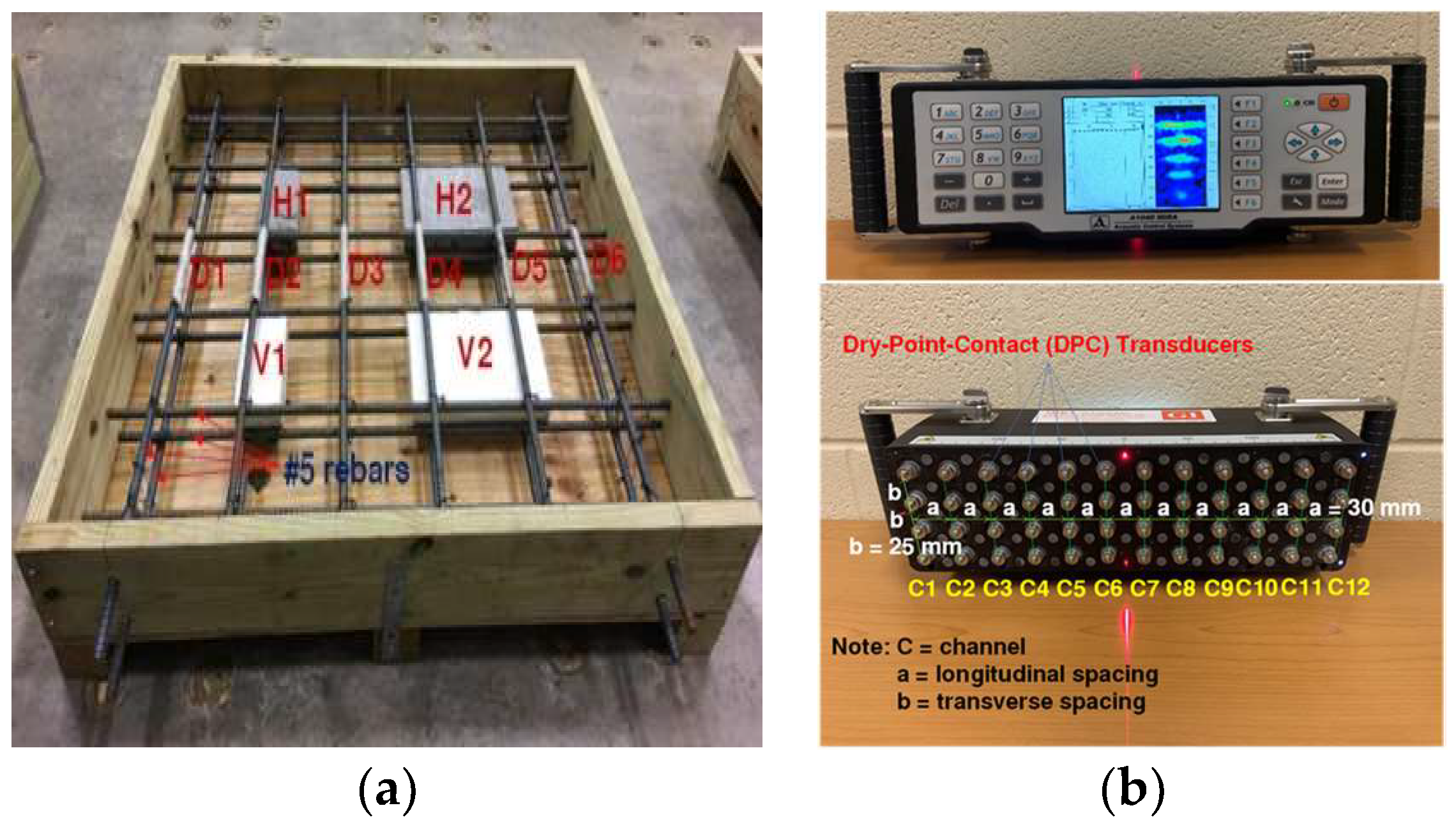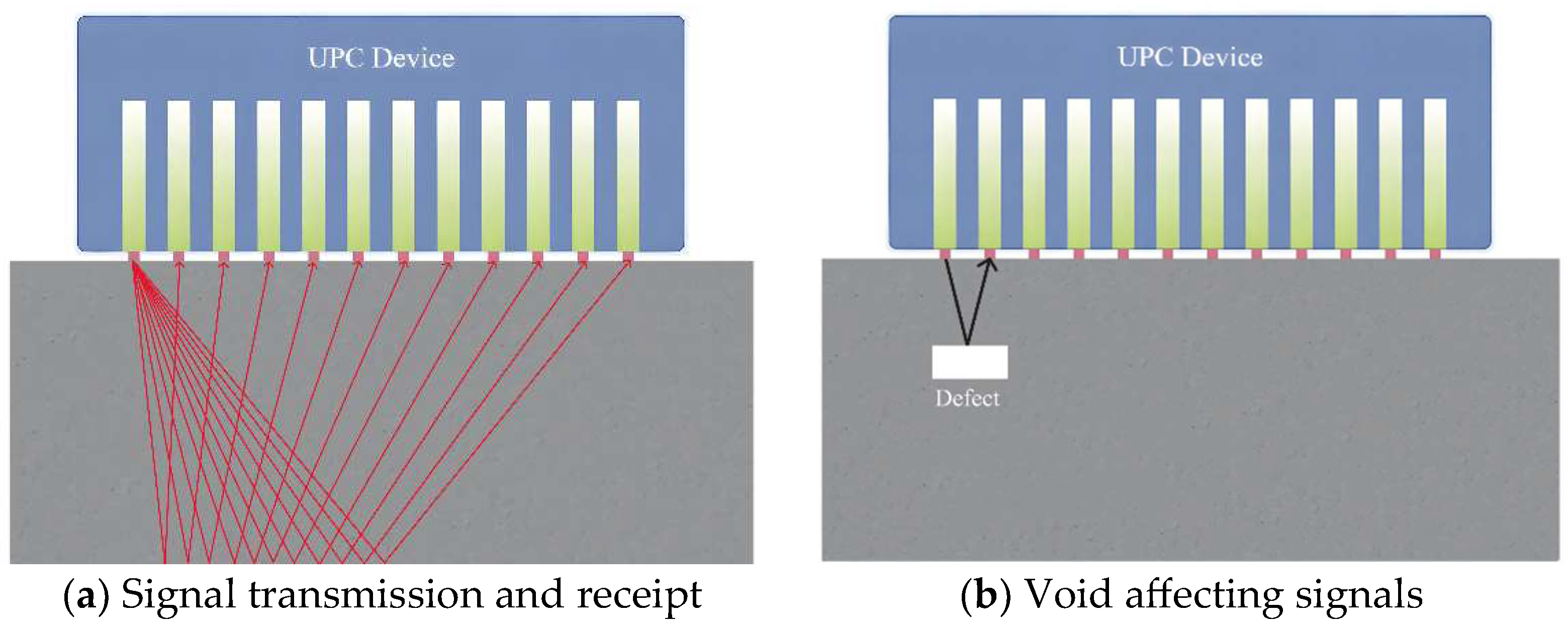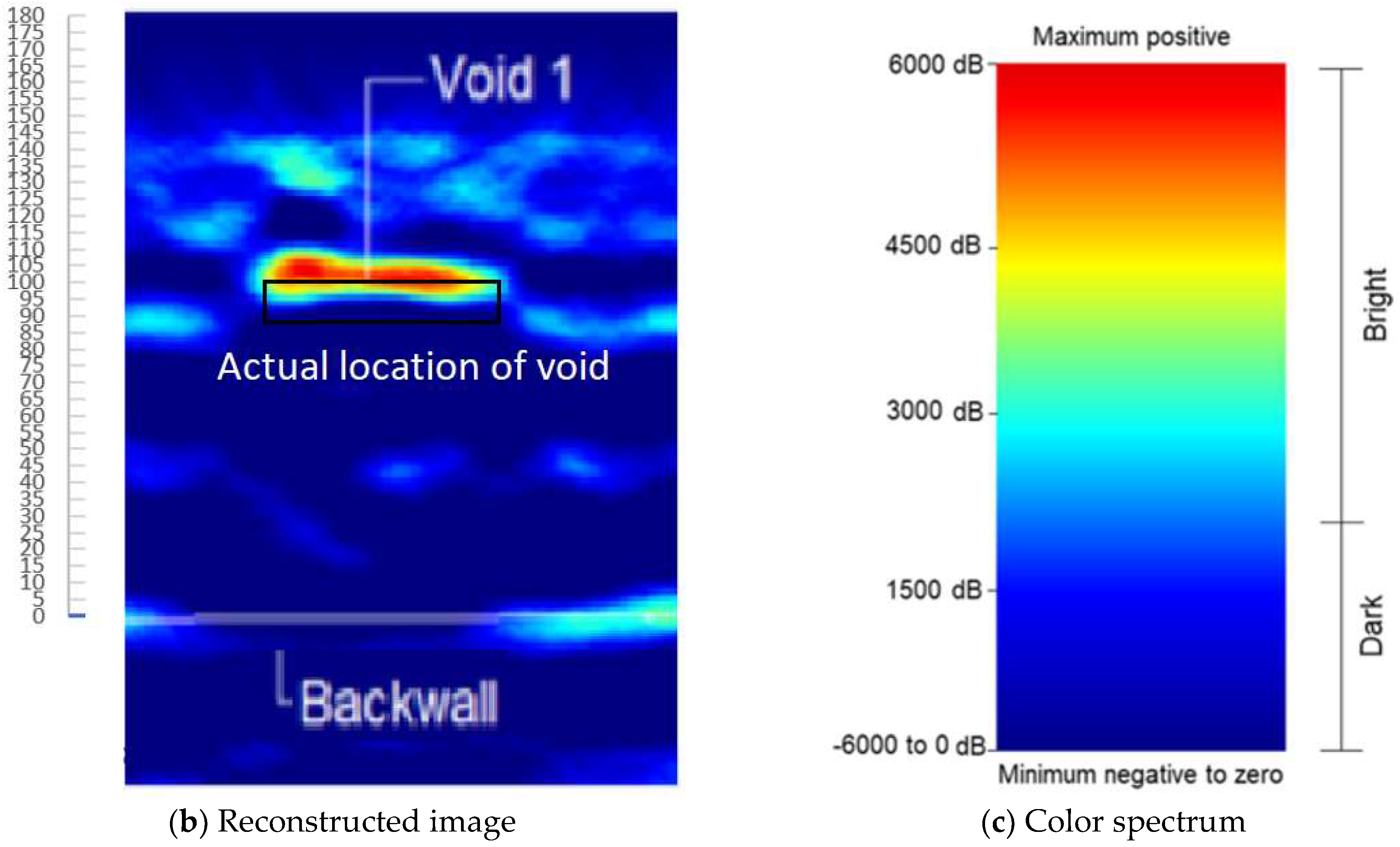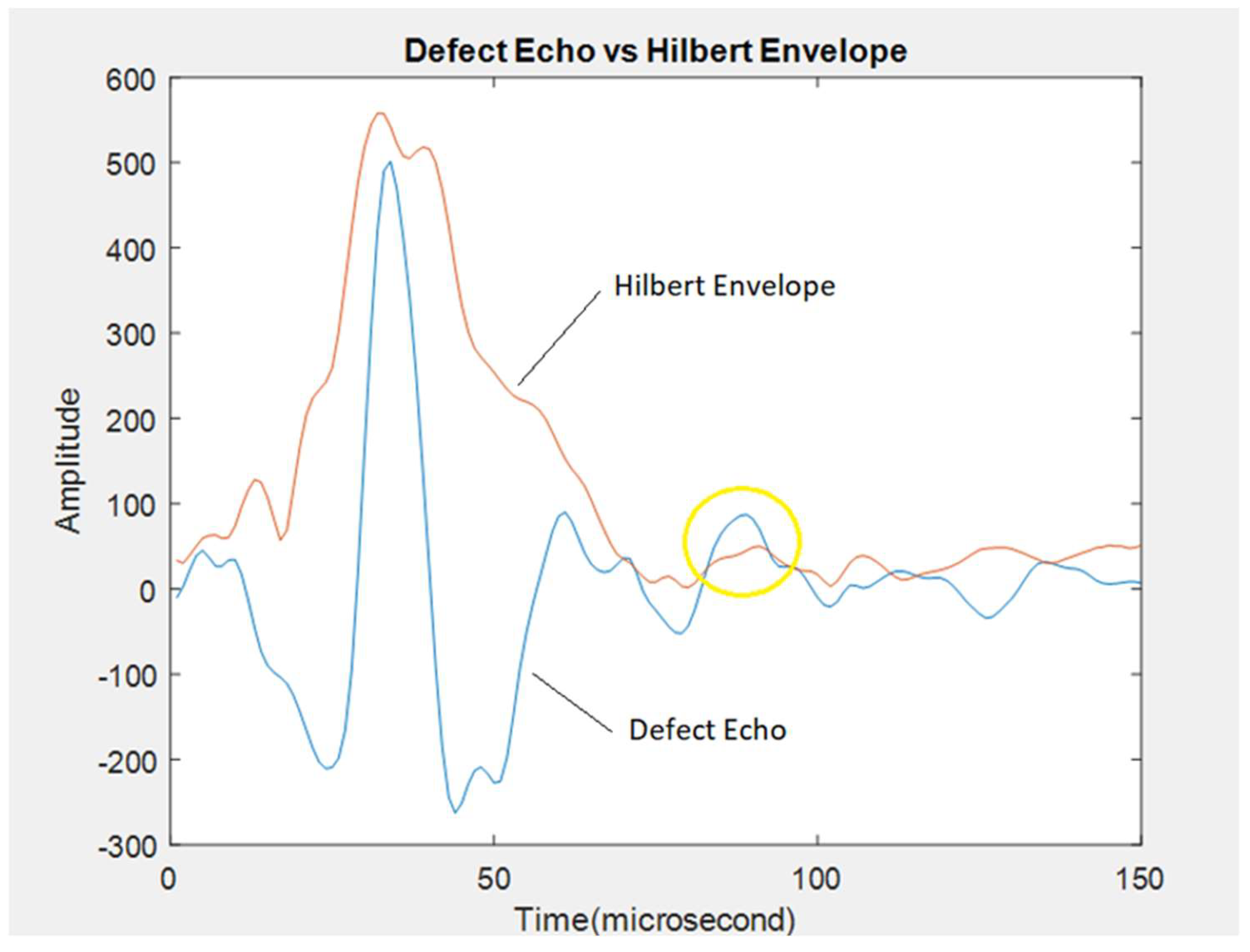Ultrasonic Pulse-Echo Signals for Quantitative Assessment of Reinforced Concrete Anomalies
Abstract
:1. Introduction
2. Experimental Setup
3. Formulation for Accurate Assessment of Void Defects
- (1)
- To accurately process the input signal, we must initially identify all local maxima and minima, along with their respective positions and amplitudes. Following this, we can employ cubic spline interpolation to generate an upper envelope consisting of the local maxima and a lower envelope using the local minima.
- (2)
- After calculating these envelopes, the envelope mean signal, known as , can be determined by taking their mean. Lastly, to finalize the processing, we need to subtract the envelope mean signal from the original input signal (Equation (4)).
- (3)
- Check if meets the IMF requirements. Treat the data as new data and repeat the process if it does not meet the IMF requirements (Equation (5)).
- (4)
- Repeat the sifting procedure k times until the resulting component is an IMF, which becomes the first IMF (Equation (6)).
- (5)
- A standard method for extracting and analyzing a signal’s underlying components is residual analysis. This process involves subtracting the component from the input signal and defining the resulting remainder as the first residual. Given that the first residual may contain information relating to longer-period components, it is treated as a new data stream. The procedure is repeated for this new signal. This process may be iterated j times, resulting in the generation of j residuals. By following this approach, it is possible to obtain a refined understanding of the signal and identify the underlying components contributing to its overall structure.
- (6)
- The sifting process is interrupted once either of the two criteria mentioned above is fulfilled: firstly, when the component or the residual is reduced to such a minuscule size that it can be regarded as insignificant, or secondly, when the residual (R) becomes a monotonic function that precludes the extraction of the IMF—the objective IMF can be obtained by adding Equations (4) and (5). The original signal can be expressed as a combination of IMFs and a residual, producing significant implications in signal processing and analysis. This observation has been accepted in the academic community.
- (7)
- EMD-based denoising, similar to other decomposition-based denoising techniques like wavelet transforms, requires a reliable and robust threshold to distinguish between noise and authentic signal components. In cases where irregularity or noise is present in a time series, the Hurst exponent plays a crucial role in determining the irregularity in the signal. This methodology is more efficient than traditional approaches such as autocorrelation, ANOVA, and spectral analysis in many applications. The Hurst exponent value, whether greater or less than 0.5, indicates the pattern of the non-linearity of the data set. Some generalized white noise signals exhibit a flat spectrum, and their statistical properties are determined solely by a scalar parameter H, known as the Hurst exponent. For a signal x(t) exhibiting a zero-mean Gaussian stationary process, its autocorrelation function is expressed as follows:where σ is the process variance of signal x(t), H is the Hurst exponent, and k is the correlation lag. Notably, when H equals 0.5, the process is classified as uncorrelated white noise, whereas for other H values, it is labeled as colored Gaussian noise. Moreover, when a generalized white noise signal is subjected to EMD, it acts as a dyadic filter bank.
- (8)
- It is important to note that the log-variance of the IMFs follows a simple linear model, which the Hurst exponent of the process ultimately governs.
- (9)
- For k ≥ 2 and , the energy of each of the IMFs can be parameterized as a function of the first IMF energy and Hurst exponent parameters [62]:
- (10)
- This particular model can execute denoising BMD-based techniques. The process entails breaking down the noisy signal into IMFs and gauging their energy levels about the estimated noise-only IMF energies derived from Equation (10). From there, the signal reconstruction is accomplished by adding up the IMFs whose energy levels deviate from the expected noise model.
- (11)
- Peak detection techniques are typically employed to estimate TOF, thereby differentiating between the reflection signal from the front surface and the reflection signal from the defect. Despite the denoising process, the defect echo signals may still exhibit dispersion and weakness, requiring specialized methods for identification and estimation. Techniques such as filtering, cross-correlation, envelop moment analysis, and matching pursuit decomposition with dispersion compensation are necessary for accurate defect detection in such scenarios. The envelope of an echo signal constitutes a vital characteristic that can be employed to extract information regarding the location of the echo waveform.The Hilbert transform facilitates the computation of instantaneous features of a time series, including the envelope amplitude and instantaneous frequency. The instantaneous envelope denotes the amplitude of the complex Hilbert transform, which can be utilized to identify the dynamic characteristics of non-linear systems by improving the accuracy of envelope detection through the use of local maxima interpolation.The Hilbert transform involves casting the actual signal a(t) into an analytical signal (i.e., complex envelope) . The ã(t) is a complex-valued time-domain signal, where the original actual signal a(t) is the genuine part, and the Hilbert transformed signal is the imaginary part (Equation (13)). By leveraging this approach, one can obtain a complex-valued time-domain signal that provides a more comprehensive representation of the underlying physical phenomenon.
- (12)
- In Equation (14), j is the imaginary number, while H[·] denotes the Hilbert transform operation. In the time domain, the Hilbert transform is defined as the convolution of a(t) with 1/πt, where â(t) = H[a(t)]. The envelope of a signal is the magnitude of the analytical signal, which is the same as the magnitude of the real signal. The complex signal ã(t) is formed by the Hilbert transform, a(t), and â(t), as shown in Equation (15). Then, the envelope of the real signal can be given by Equation (16).
4. Results and Discussion
5. Conclusions
- Advanced signal processing methods are used to accurately evaluate the location of the void defects in concrete decks, whereas the imaging of commercialized ultrasonic devices usually gives qualitative information about defects.
- A concrete deck slab specimen with artificial void defects is used for validation. A commercial ultrasonic pulse-echo device, based on the ultrasonic shear-wave test method using dry-point-contact transmitting and receiving transducers, and extended SAFT were employed to map the internal void defect of the validation concrete deck slab specimens.
- The recorded data from the ultrasonic pulse-echo device was analyzed by using the proposed methods to accurately evaluate the void defect locations in the concrete deck slab specimen. The new method consists of benchmark envelope estimation and the denoise of the echo signal, which identifies the weak stochastic and non-stationary echo signal from void defects.
- The results demonstrated that the proposed method accurately located the void defects in the concrete deck specimen. In contrast, the commercial ultrasonic pulse-echo device’s map for the void defects of the concrete deck can only give qualitative results.
- The cost of application of the new method and procedure is low, as the A-scan is always available for UPE testing, and all the related algorithms have been well developed.
- The direction to extend the current study is to apply and evaluate the proposed method to other kinds of subsurface anomalies of concrete, such as irregular crack, rebar/corrosion, etc.
Author Contributions
Funding
Institutional Review Board Statement
Informed Consent Statement
Data Availability Statement
Acknowledgments
Conflicts of Interest
References
- Kot, P.; Muradov, M.; Gkantou, M.; Kamaris, G.S.; Hashim, K.; Yeboah, D. Recent Advancements in Non-Destructive Testing Techniques for Structural Health Monitoring. Appl. Sci. 2021, 11, 2750. [Google Scholar] [CrossRef]
- Zheng, Y.; Wang, S.; Zhang, P.; Xu, T.; Zhuo, J. Application of Nondestructive Testing Technology in Quality Evaluation of Plain Concrete and RC Structures in Bridge Engineering: A Review. Buildings 2022, 12, 843. [Google Scholar] [CrossRef]
- Davis, A.; Ansari, F.; Gaynor, R.; Lozen, K.; Rowe, T.; Caratin, H.; Heidbrink, F.; Malhotra, V.; Simons, B.; Carino, N. Nondestructive Test Methods for Evaluation of Concrete in Structures; American Concrete Institute, ACI: Farmington Hills, MI, USA, 1998; Volume 228. [Google Scholar]
- Schickert, M. Towards SAFT-imaging in ultrasonic inspection of concrete. In Proceedings of the International Symposium Non-Destructive Testing in Civil Engineering, Berlin, Germany, 26–28 September 1995. [Google Scholar]
- Schickert, M.; Krause, M.; Müller, W. Ultrasonic Imaging of Concrete Elements Using Reconstruction by Synthetic Aperture Focusing Technique. J. Mater. Civ. Eng. 2003, 15, 235–246. [Google Scholar] [CrossRef]
- Hoegh, K.; Khazanovich, L. Extended synthetic aperture focusing technique for ultrasonic imaging of concrete. NDT E Int. 2015, 74, 33–42. [Google Scholar] [CrossRef]
- Havugarurema, J.B.; Sackey, S.H.; Nkurunziza, P.; Nsegiyumva, E. Damage detection in concrete using synthetic aperture focusing technique. Int. J. Sci. Eng. Sci. 2020, 4, 40–47. [Google Scholar]
- Hosseini, Z.; Momayez, M.; Hassani, F.; Lévesque, D. Detection of inclined cracks inside concrete structures by ultrasonic saft. AIP Conf. Proc. 2008, 975, 1298–1304. [Google Scholar] [CrossRef]
- Tong, J.; Chiu, C.; Wang, C. Improved Synthetic Aperture Focusing Technique by Hilbert-Huang Transform for Imaging Defects inside a Concrete Structure. IEEE Trans. Ultrason. Ferroelectr. Freq. Control 2010, 57, 2512–2521. [Google Scholar] [CrossRef]
- De La Haza, A.O.; Samokrutov, A.A.; Samokrutov, P.A. Assessment of Concrete Structures Using the Mira and Eyecon Ultrasonic Shear Wave Devices and the SAFT-C Image Reconstruction Technique. Constr. Build. Mater. 2013, 38, 1276–1291. [Google Scholar] [CrossRef]
- Blitz, J.; Simpson, G. Ultrasonic Methods of Non-Destructive Testing; Springer Science & Business Media: Berlin/Heidelberg, Germany, 1995; ISBN 978-0-412-60470-6. [Google Scholar]
- Karaiskos, G.; Deraemaeker, A.; Aggelis, D.G.; Hemelrijck, D.V. Monitoring of Concrete Structures Using the Ultrasonic Pulse Velocity Method. Smart Mater. Struct. 2015, 24, 113001. [Google Scholar] [CrossRef]
- Felice, M.V.; Fan, Z. Sizing of Flaws Using Ultrasonic Bulk Wave Testing: A Review. Ultrasonics 2018, 88, 26–42. [Google Scholar] [CrossRef]
- Clayton, D.A.; Smith, C.M.; Ferraro, D.C.C.; Nelson, J.; Khazanovich, D.L.; Hoegh, D.K.; Chintakunta, S.; Popovics, D.J. Evaluation of Ultrasonic Techniques on Concrete Structures; No. ORNL/TM-2013/430; Oak Ridge National Lab. (ORNL): Oak Ridge, TN, USA, 2013. [Google Scholar]
- Choi, H.; Bittner, J.; Popovics, J.S. Comparison of Ultrasonic Imaging Techniques for Full-Scale Reinforced Concrete. Transp. Res. Rec. 2016, 2592, 126–135. [Google Scholar] [CrossRef]
- Popovics, J.S.; Roesler, J.R.; Bittner, J.; Amirkhanian, A.N.; Brand, A.S.; Gupta, P.; Flowers, K. Ultrasonic Imaging for Concrete Infrastructure Condition Assessment and Quality Assurance; Illinois Center for Transportation Series No. 17-011, Research Report No. FHWA-ICT-17-007; Illinois Center for Transportation/Illinois Department of Transportation: Rantoul, IL, USA, 2017. [Google Scholar]
- Hoegh, K.; Khazanovich, L.; Ferraro, C.; Clayton, D. Ultrasonic Linear Array Validation via Concrete Test Blocks. AIP Conf. Proc. 2015, 1650, 83–93. [Google Scholar] [CrossRef]
- Bishko, A.; Samokrutov, A.A.; Shevaldykin, V.G. Ultrasonic echo-pulse tomography of concrete using shear waves low-frequency phased antenna arrays. In Proceedings of the 17th World Conference on Nondestructive Testing, Shanghai, China, 25–28 October 2008; p. 2008. [Google Scholar]
- Zhao, H.; Song, P.; Urban, M.W.; Kinnick, R.R.; Yin, M.; Greenleaf, J.F.; Chen, S. Bias Observed in Time-of-Flight Shear Wave Speed Measurements Using Radiation Force of a Focused Ultrasound Beam. Ultrasound Med. Biol. 2011, 37, 1884–1892. [Google Scholar] [CrossRef]
- Haslinger, S.G.; Lowe, M.J.S.; Huthwaite, P.; Craster, R.V.; Shi, F. Elastic Shear Wave Scattering by Randomly Rough Surfaces. J. Mech. Phys. Solids 2020, 137, 103852. [Google Scholar] [CrossRef]
- Deng, Y.; Rouze, N.C.; Palmeri, M.L.; Nightingale, K.R. On System-Dependent Sources of Uncertainty and Bias in Ultrasonic Quantitative Shear-Wave Imaging. IEEE Trans. Ultrason. Ferroelectr. Freq. Control 2016, 63, 381–393. [Google Scholar] [CrossRef]
- Lin, S.; Shams, S.; Choi, H.; Azari, H. Ultrasonic Imaging of Multi-Layer Concrete Structures. NDT E Int. 2018, 98, 101–109. [Google Scholar] [CrossRef]
- Jain, H.; Patankar, V.H. Advances in Ultrasonic Instrumentation for Inspection of Concrete/RCC Structures. In Proceedings of the NDE 2018 Conference & Exhibition of the Society for NDT (ISNT), Mumbai, India, 19–21 December 2018. [Google Scholar]
- Rathod, H.; Gupta, R. Two-Dimensional Non-Destructive Testing Data Maps for Reinforced Concrete Slabs with Simulated Damage. Data Brief 2019, 25, 104127. [Google Scholar] [CrossRef]
- Rathod, H.; Gupta, R. Sub-Surface Simulated Damage Detection Using Non-Destructive Testing Techniques in Reinforced-Concrete Slabs. Constr. Build. Mater. 2019, 215, 754–764. [Google Scholar] [CrossRef]
- Ezell, N.D.B.; Venkatakrishnan, S.V.; Al Mansouri, H.; Santos-Villalobos, H.; Floyd, D. High fidelity ultrasound imaging of concrete structures. In Proceedings of the Smart Structures and NDE for Energy Systems and Industry 4.0, Denver, CO, USA, 4–5 March 2019; pp. 151–159. [Google Scholar]
- Ohara, Y.; Kikuchi, K.; Tsuji, T.; Mihara, T. Development of Low-Frequency Phased Array for Imaging Defects in Concrete Structures. Sensors 2021, 21, 7012. [Google Scholar] [CrossRef]
- Rabe, U.; Pudovikov, S.; Herrmann, H.-G.; Wiggenhauser, H.; Prabhakara, P.; Niederleithinger, E. Using the Corner Reflection for Depth Evaluation of Surface Breaking Cracks in Concrete by Ultrasound. J. Nondestruct. Eval. 2023, 42, 44. [Google Scholar] [CrossRef]
- Kuchipudi, S.T.; Pudovikov, S.; Wiggenhauser, H.; Ghosh, D.; Rabe, U. Imaging of Vertical Surface-Breaking Cracks in Concrete Members Using Ultrasonic Shear Wave Tomography. Sci. Rep. 2023, 13, 21744. [Google Scholar] [CrossRef] [PubMed]
- Maack, S.; Küttenbaum, S.; Bühling, B.; Borchardt-Giers, K.; Aßmann, N.; Niederleithinger, E. Low Frequency Ultrasonic Pulse-Echo Datasets for Object Detection and Thickness Measurement in Concrete Specimens as Testing Tasks in Civil Engineering. Data Brief 2023, 48, 109233. [Google Scholar] [CrossRef] [PubMed]
- Mehdinia, S.; Schumacher, T.; Song, X.; Wan, E. A Pipeline for Enhanced Multimodal 2D Imaging of Concrete Structures. Mater. Struct. 2021, 54, 228. [Google Scholar] [CrossRef]
- Mayakuntla, P.K.; Ghosh, D.; Ganguli, A. Classification of Corrosion Severity in Concrete Structures Using Ultrasonic Imaging and Linear Discriminant Analysis. Sustainability 2022, 14, 15768. [Google Scholar] [CrossRef]
- Kwon, H.; Joh, C.; Chin, W.J. Pulse Peak Delay-Total Focusing Method for Ultrasonic Tomography on Concrete Structure. Appl. Sci. 2021, 11, 1741. [Google Scholar] [CrossRef]
- Kwon, H.; Joh, C.; Chin, W.J. 3D Internal Visualization of Concrete Structure Using Multifaceted Data for Ultrasonic Array Pulse-Echo Tomography. Sensors 2021, 21, 6681. [Google Scholar] [CrossRef] [PubMed]
- Zatar, W.A.; Nguyen, H.D.; Nghiem, H.M. Ultrasonic Pitch and Catch Technique for Non-Destructive Testing of Reinforced Concrete Slabs. J. Infrastruct. Preserv. Resil. 2020, 1, 12. [Google Scholar] [CrossRef]
- Zatar, W.; Nguyen, T.; Nguyen, H. Environmental effects on condition assessments of concrete structures with ground penetrating radar. J. Appl. Geophys. 2022, 203, 104713. [Google Scholar] [CrossRef]
- Zatar, W.; Nguyen, H.; Nghiem, H. FRP Retrofitting and Non-Destructive Evaluation for Corrosion-Deteriorated Bridges in West Virginia. In International Concrete Abstracts Portal; Special Publication; American Concrete Institute (ACI): Farmington Hills, MI, USA, 2021; Volume 346, pp. 11–30. [Google Scholar]
- Zatar, W.; Nghiem, H. Detectability of embedded defects in FRP strengthened concrete deck slabs. In Risk-Based Strategies for Bridge Maintenance; CRC Press: Boca Raton, FL, USA, 2023; pp. 221–234. [Google Scholar]
- Zatar, W.; Hua, X.; Chen, G.; Nguyen, H.; Nghiem, H. Evaluating the Properties of Railway Ballast Using Spectral Analysis of Ground Penetrating Radar Signal Based on Optimized Variational Mode Decomposition. Adv. Civ. Eng. 2022, 2022, 2840318. [Google Scholar] [CrossRef]
- Zatar, W.A.; Nguyen, H.D.; Nghiem, H.M.; Cosgun, C. Non-Destructive Testing of GFRP-Wrapped Reinforced-Concrete Slabs (No. TRBAM-21-03354). 2021. Available online: https://trid.trb.org/view/1758973 (accessed on 27 January 2021).
- Zatar, W.; Nguyen, H.; Nghiem, H. Nondestructive Evaluation of Reinforced Concrete Slabs Rehabilitated with Glass Fiber-Reinforced Polymers. In International Concrete Abstracts Portal; Special Publication; American Concrete Institute (ACI): Farmington Hills, MI, USA, 2022; Volume 356, pp. 224–237. [Google Scholar]
- Zatar, W.; Nguyen, H.D.; Nghiem, H.M. Influence of Frequencies of Ground-Penetrating Radar Antennas on Detectability of Defects and Image Reconstructability of Concrete Structures. In Proceedings of the Ninth Congress on Forensic Engineering, Denver, CO, USA, 4–7 November 2022; pp. 620–630. [Google Scholar]
- Tayfur, S. Assessing the Influences of Noise Suppression Filters on Ultrasonic Concrete Images Generated by an Innovative CMU-SAFT Algorithm. Arab. J. Sci. Eng. 2024, 1–14. [Google Scholar] [CrossRef]
- Mehdinia, S.; Murtuz, A.K.M.G.; Schumacher, T.; Dusicka, P. Damage Tracking in Laboratory Reinforced Concrete Bridge Columns under Reverse-Cyclic Loading Using Fusion-Based Imaging. Nondestruct. Test. Eval. 2024, 39, 536–556. [Google Scholar] [CrossRef]
- Zhang, T.; Zhang, L.; Ozevin, D.; Attard, T. Multi-Scale Ultrasonic Imaging of Sub-Surface Concrete Defects. Meas. Sci. Technol. 2023, 35, 035901. [Google Scholar] [CrossRef]
- San Emeterio, J.L.; Rodriguez-Hernandez, M.A. Wavelet Denoising of Ultrasonic A-Scans for Detection of Weak Signals. In Proceedings of the 2012 19th International Conference on Systems, Signals and Image Processing (IWSSIP), Vienna, Austria, 11–13 April 2012; pp. 48–51. [Google Scholar]
- Hoseini, M.R.; Zuo, M.J.; Wang, X. Denoising Ultrasonic Pulse-Echo Signal Using Two-Dimensional Analytic Wavelet Thresholding. Measurement 2012, 45, 255–267. [Google Scholar] [CrossRef]
- Sharma, G.K.; Kumar, A.; Jayakumar, T.; Purnachandra Rao, B.; Mariyappa, N. Ensemble Empirical Mode Decomposition Based Methodology for Ultrasonic Testing of Coarse Grain Austenitic Stainless Steels. Ultrasonics 2015, 57, 167–178. [Google Scholar] [CrossRef] [PubMed]
- Zhu, Y.; Xu, C.; Xiao, D. Denoising Ultrasonic Echo Signals with Generalized S Transform and Singular Value Decomposition. Trait. Signal 2019, 36, 139–145. [Google Scholar] [CrossRef]
- Li, Z.; Xu, H.; Jiang, B.; Han, F. Wavelet Threshold Ultrasound Echo Signal Denoising Algorithm Based on CEEMDAN. Electronics 2023, 12, 3026. [Google Scholar] [CrossRef]
- Bouchair, A.; Selouani, S.A.; Amrouche, A.; Sidi Yakoub, M. Improved Empirical Mode Decomposition Using Optimal Recursive Averaging Noise Estimation for Speech Enhancement. Circuits Syst. Signal Process. 2022, 41, 196–223. [Google Scholar] [CrossRef]
- Zhang, Z.; Xie, H.; Tong, X.; Zhang, H.; Liu, Y.; Li, B. Denoising for Satellite Laser Altimetry Full-Waveform Data Based on EMD-Hurst Analysis. Int. J. Digit. Earth 2020, 13, 1212–1229. [Google Scholar] [CrossRef]
- Luo, H.; Fang, X.; Ertas, B. Hilbert Transform and Its Engineering Applications. AIAA J. 2009, 47, 923–932. [Google Scholar] [CrossRef]
- Yoo, J.-H.; Cho, S.-H. Advanced Synchronization Check Method Using Hilbert Transform-Based Voltage Envelope Analysis. J. Electr. Eng. Technol. 2023, 18, 4463–4471. [Google Scholar] [CrossRef]
- Watanabe, T.; Morita, T.; Hashimoto, C.; Ohtsu, M. Detecting Voids in Reinforced Concrete Slab by SIBIE. Constr. Build. Mater. 2004, 18, 225–231. [Google Scholar] [CrossRef]
- Gu, J.-C.; Unjoh, S.; Naito, H. Detectability of Delamination Regions Using Infrared Thermography in Concrete Members Strengthened by CFRP Jacketing. Compos. Struct. 2020, 245, 112328. [Google Scholar] [CrossRef]
- Gu, J.; Unjoh, S. Image Processing Methodology for Detecting Delamination Using Infrared Thermography in CFRP-Jacketed Concrete Members by Infrared Thermography. Compos. Struct. 2021, 270, 114040. [Google Scholar] [CrossRef]
- Kabir, E. Nondestructive Evaluation of Structural Defects in Concrete Slabs. Ph.D. Thesis, Georgia Southern University, Statesboro, GA, USA, 2023. [Google Scholar]
- Zhang, M.; Wei, G. An Integrated EMD Adaptive Threshold Denoising Method for Reduction of Noise in ECG. PLoS ONE 2020, 15, e0235330. [Google Scholar] [CrossRef] [PubMed]
- Feng, W.; Zhou, X.; Zeng, X.; Yang, C. Ultrasonic Flaw Echo Enhancement Based on Empirical Mode Decomposition. Sensors 2019, 19, 236. [Google Scholar] [CrossRef] [PubMed]
- Duan, D.; Ma, H.; Yan, Y.; Yang, Q. A Fault Diagnosis Scheme Using Hurst Exponent for Metal Particle Faults in GIL/GIS. Sensors 2022, 22, 862. [Google Scholar] [CrossRef] [PubMed]
- Haider, N.S. Respiratory Sound Denoising Using Empirical Mode Decomposition, Hurst Analysis and Spectral Subtraction. Biomed. Signal Process. Control 2021, 64, 102313. [Google Scholar] [CrossRef]
- Zhu, W.-F.; Chen, X.-J.; Li, Z.-W.; Meng, X.-Z.; Fan, G.-P.; Shao, W.; Zhang, H.-Y. A SAFT Method for the Detection of Void Defect inside a Ballastless Track Structure Using Ultrasonic Array Sensors. Sensors 2019, 19, 4677. [Google Scholar] [CrossRef]









| Method | Experimental Specimen | UPE Device | New Method |
|---|---|---|---|
| Distance from surface (mm) | 83 | 70–75 | 82 |
Disclaimer/Publisher’s Note: The statements, opinions and data contained in all publications are solely those of the individual author(s) and contributor(s) and not of MDPI and/or the editor(s). MDPI and/or the editor(s) disclaim responsibility for any injury to people or property resulting from any ideas, methods, instructions or products referred to in the content. |
© 2024 by the authors. Licensee MDPI, Basel, Switzerland. This article is an open access article distributed under the terms and conditions of the Creative Commons Attribution (CC BY) license (https://creativecommons.org/licenses/by/4.0/).
Share and Cite
Zatar, W.; Chen, G.; Nghiem, H.; Xiao, F. Ultrasonic Pulse-Echo Signals for Quantitative Assessment of Reinforced Concrete Anomalies. Appl. Sci. 2024, 14, 4860. https://doi.org/10.3390/app14114860
Zatar W, Chen G, Nghiem H, Xiao F. Ultrasonic Pulse-Echo Signals for Quantitative Assessment of Reinforced Concrete Anomalies. Applied Sciences. 2024; 14(11):4860. https://doi.org/10.3390/app14114860
Chicago/Turabian StyleZatar, Wael, Gang Chen, Hien Nghiem, and Feng Xiao. 2024. "Ultrasonic Pulse-Echo Signals for Quantitative Assessment of Reinforced Concrete Anomalies" Applied Sciences 14, no. 11: 4860. https://doi.org/10.3390/app14114860





